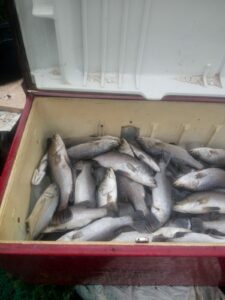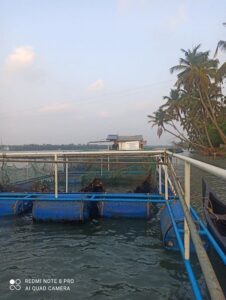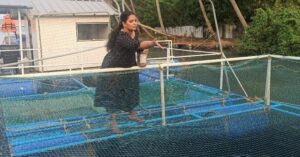Around 40 metres from the banks of Periyar River, near Moothakunnam in Ernakulam, you can see numerous cages in which many varieties of fishes are grown. Tending to and guarding them is 38-year-old Smija M B, who regularly feeds and harvests the fish.
In 2018, the Department of Fishers came up with its cage fishing project, as part of the Blue Revolution. With global fish production on the decline due to climate change, the project aims to encourage more farmers to enter the field, especially women and members of scheduled castes/tribes. Around 500 cages were supplied to Kerala as part of this. The project began in Kannur, and later reached Ernakulam, where Smija, who also works as a workshop instructor at SNM INT Engineering College, decided to take up the cause.
Cage fishing, or cage culture, involves growing fishes in existing water resources like rivers, ponds, lakes or sea. This allows the fish to remain in free flowing water, while being enclosed in a net cage made of a floating frame, net materials and mooring system. Cage farms are positioned in such a way so as to utilise natural currents, which provide the fish with oxygen and other appropriate natural conditions.
‘Women-friendly cage fishing’
“I grew up in a family of fishing labourers, which helped me develop a genuine interest in the field. My husband, too, adores aquaculture and fish breeding. Earlier, we used to do this on a small scale. We took up cage fishing mainly because neither of us had a permanent job,” Smija tells The Better India.
Many women from Smija’s locality became part of the project with technical guidance from the Central Marine Fisheries Research Institute (CMFRI), she says.
In order to farm in the river area, a no objection certificate has to be acquired from the panchayat, by which the farmer gets hold of a fisheries licence. It has to be refurbished every year by paying an amount based on the area used.
Apart from the subsidy provided by the CMFRI, Smija, her husband Unnikrishnan, and three other shareholders, invested around Rs 10 lakh in this farm.
They started off by installing three cages with four types of fishes — sea bass, bluefin trevally, green chromide and mangrove red snapper.

“The 2018 floods adversely affected us, but luckily not many fishes were lost. The market became dull and the price of fish went down. We pitched in whatever profit we had gained and expanded farming. Four more cages were installed and we made a small house near the farm area to keep a watch on them 24/7,” Smija explains.

In addition to the back-to-back floods, COVID-19 has also posed a challenge to the farmer, mainly due to lack of access to adequate feed. “As both of us are working, farming is now a side business. Despite that, we are able to earn double our annual investment. For instance, last year, we invested around Rs 2 lakh and were able to earn Rs 4-5 lakh,” Smija explains. “If enough feed is available and thorough care is given, this can be a more successful and income-generating business idea capable of meeting the requirements of a whole family.” she adds.
The harvesting period of each fish is different, Smija notes, ranging from six months to two years. She sells them wholesale to nearby markets and retail to individuals. During holidays, the couple gives special offers publicised through social media and banners, which make faster sales, they say.
Smija was honoured by CMFRI on Women’s Day 2021. This national level award made her popular among aquaculture farmers in and out of the state, she says.

She adds that many women in her neighbourhood have taken up cage fishing after seeing her success. “At least 10 local women organisations approached us for details. Also, research students of aquaculture visit the farm to take notes of the methods I implement here. Before the pandemic, at least 20 used to drop by every month,” says the farmer. “I also help women get in touch with required authorities to start cage fishing.”
Get in touch with Smija at 8281389975 to know more about cage fishing.
Sources:
(Edited by Divya Sethu)
No comments:
Post a Comment